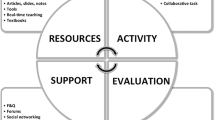Abstract
This paper describes a study that explored the utility and efficacy of the application of a Web-based tool to promote learner engagement among first year students in a large class in an undergraduate communications degree. The Web-based tool was developed to support an inquiry-based learning approach that was characterised by strong learning scaffolds, meaningful contexts, feedback and support and administrative efficiencies. The study explored the forms of engagement that the Web-supported inquiry-based learning approach was able to engender among first year undergraduate students and the factors that were found to influence students’ levels of engagement and achievement in the approach.


Similar content being viewed by others
References
Anderson L.W., & Krathwohl D.R. (Eds.). (2001). A taxonomy of learning, teaching, and assessment: A revision of bloom’s taxonomy of educational objectives. New York: Longman.
Biggs, J. (1999). Teaching for quality learning at University. Buckingham: Open University Press.
Bligh, J. (1995). Problem-based learning in medicine: An introduction. Post-Graduate Medical Journal, 71(8), 323–326.
Bloom, B. (1956). (Eds.). Taxonomy of educational objectives, handbook I: Cognitive domain. New York: Longmans, Green.
Boud, D., & Prosser, M. (2002). Key principles for high quality student learning in higher education: A framework for evaluation. Educational Media International, 39 (3), 237–245.
Calder, A., & Hanley, P. (2004). Transition—helping students bridge the gap. Issues of Teaching and Learning @ JCU, 2(2). Retrieved January 2005, from http://www.jcu.edu.au/office/tld/teachingsupport/documents/TLD_vol2_issue2.pdf.
Collis, B., & Moonen, J. (2001). Flexible learning in a digital world. London: Kogan Page.
Dolmans, D. (1992). The relationship between student-generated learning issues and self-study in problem-based learning. Instructional Science, 22 (4), 251–267.
Fogarty, R. (1997). Problem-based learning and other curriculum models for the multiple intelligences classroom. ERIC Document No. ED405143.
Gijbels, D., Dochy, F., Van den Bossche, P., & Segers, M. (2005). Effects of problem-based learning: A meta-analysis from the angle of assessment. Review of Educational Research, 75(1), 27–61.
Goodyear, P. (2005). The emergence of a networked learning community: Lessons learned from research and practice. In G. Kearsley (Ed.), Online learning: Personal reflections on the transformation of education (pp. 113–127). Englewood Cliffs, NJ: Educational Technology Publications.
Hutchins, E. (1995). Cognition in the wild. Boston, MIT Press.
Jonassen, D. (2000). Toward a design theory of problem solving. Educational Technology Research and Development, 48(4), 63–85.
Kearsley, G., & Shneiderman, B. (1999). Engagement theory: A framework for technology-based teaching and learning. Retrieved July, 2003, from http://home.sprynet.com/∼gkearsley/engage.htm.
Kearsley G. (2005). (Eds.). Online learning: Personal reflections of the transformation of education. Englewood Cliffs, NJ: Educational Technology Publications.
Kingsland, A. (1996). Time expenditure, workload, and student satisfaction in problem-based learning. In L. Wilkerson & W. H. Gijselaers (Eds.), Bringing problem-based learning to higher education: Theory and practice (pp.73-81). San Francisco: Jossey-Bass.
Herrington, J., Oliver, R., & Reeves, T. (2003). Patterns of engagement in authentic learning environments. Australian Journal of Educational Technology, 19(1), 59–71.
Laurillard, D. (2002). Rethinking University teaching: A conversational framework for the effective use of learning technologies (2nd ed.). London: Routledge Falmer Press.
McInnis, C., James, R., & Hartley, R. (2000). Trends in the first year experience in Australian Universities. DETYA: Canberra.
Oliver, R. (2005). Using blended learning approaches to support problem-based learning with first year students in large undergraduate classes. In C. K. Looi, D. Jonassen, M. Ikeda (Eds.), Towards sustainable and scalable educational innovations informed by the learning sciences. (pp 848–851). Amsterdam: IOS Press.
Ramsden, P. (1992). Learning to teach in higher education. London: Routledge.
Reeves, T. C., Herrington, J., & Oliver, R. (2005). Design research: A socially responsible approach to instructional technology research in higher education. Journal of Computing in Higher Education, 16 (2), 96–115.
Schiller, J., Ostwald, M., & Chen, S. (1994). Implementing a problem-based, distance education undergraduate course in construction management. Distance Education, 15(2), 300–317.
Scott, J., Buchanan, J., & Haigh, N. (1997). Reflections of student-centred learning in a large class setting. British Journal of Educational Technology, 28 (1), 19–30.
Trigwell, K., Prosser, M., & Waterhouse, F. (1999). Relations between teachers’ approaches to teaching and students’ approaches to learning. Higher Education, 37, 57–70.
Tynjala, P., Valimaa, J., & Sarja, A. (2003). Pedagogical perspectives on the relationship between higher education and working life. Higher Education, 46(2), 147–166.
Author information
Authors and Affiliations
Corresponding author
Rights and permissions
About this article
Cite this article
Oliver, R. Engaging first year students using a Web-supported inquiry-based learning setting. High Educ 55, 285–301 (2008). https://doi.org/10.1007/s10734-007-9055-7
Received:
Accepted:
Published:
Issue Date:
DOI: https://doi.org/10.1007/s10734-007-9055-7




